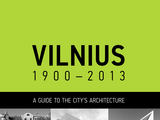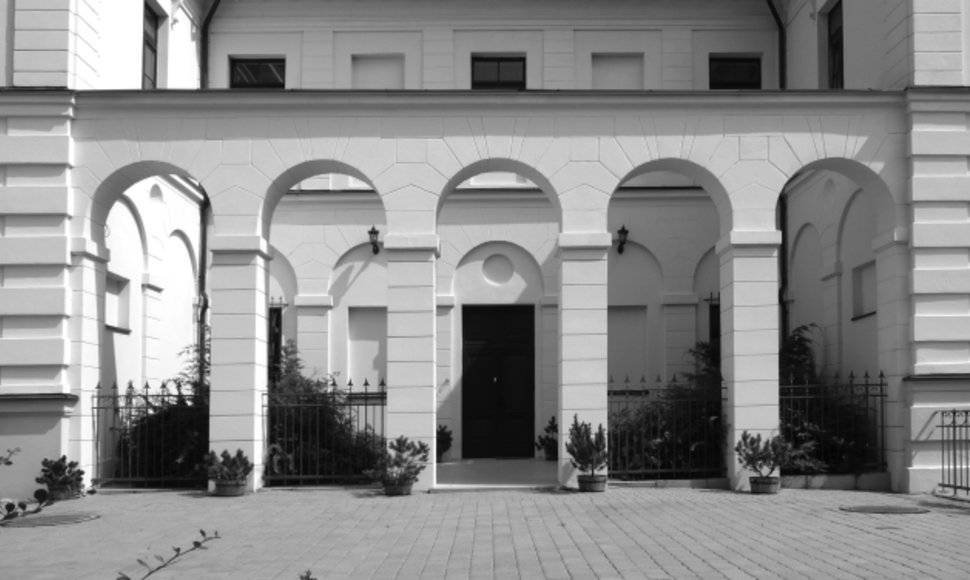 |
| Book cover |
The following is an extract from the English-language publication Vilnius 1900–2013. A Guide to the City's Architecture. The first part of the article can be accessed here.
At the dawn of the 20th century, the elegant Central European Sezession style was still in vogue. Architecture later progressed to the stripped-down interwar Modernism of the 1920s and 1930s, and after the Second World War it ventured into the controversial Soviet-imposed Neoclassicism. After ‘totalitarian’ architecture was officially condemned in the mid-1950s, postwar Modernism flourished, particularly in the new residential districts that were built to house the city’s growing population. At the end of the Soviet period, Late Modernism saw a large number of public buildings appear around the city centre.
With the reestablishment of independence in 1990, and with the consequent changes that took place in the economy and in society, Vilnius experienced yet another wave of urbanisation. Private houses were built again, filling the city to the limits, and a spectacular steel and glass city centre took shape on the right bank of the River Neris.
www.facebook.com/VilniusArchitectureGuide
The First Wave of Urbanisation (late 19th and early 20th century). Imperial Industrialisation
When Lithuania became part of Imperial Russia, and Vilnius became the centre of a governorate, the face of the city gradually began to change. The Russian Empire systematically destroyed signs of Lithuanian statehood. After 1800, in a short period of time, the city walls, the Lower Castle (at first sight quite utilitarian, but in essence very symbolic), the buildings around the Cathedral, and the city gates were demolished. The area was developed according to rules of geometric planning and French Classicism, which was popular in Russia.
This is very apparent in the first plan for the city, prepared in 1817 (by V. Guesti, G. Velikorodov and J. Poussier), according to which the city was to be expanded in every direction, with a new street stretching from the Cathedral towards Lukiškės, which was later paved and called Georgiyevsky Avenue. This plan, with the central street as an axis and smaller streets off it, and a Russian Orthodox church at the end as an obvious symbol of political and religious ideology, recalls the typical plans of Russian cities.
The second development plan, prepared in 1837 (by the engineer Serebryakov), essentially complemented the first, by suggesting some environmental ideas, building regulations and the formation of squares.
Development picked up only at the end of the 19th century. When the social and economic conditions were favourable, industry had grown and the railway had been built, the city’s development was fulfilled according to a third plan, prepared in 1875 (its instigator is unknown), which remained in force almost up to the Second World War. It suggested the regular rectangular street plan of the Naujamiestis area, and perimetrical quarters (in which industry also thrived).
The Žvėrynas area was developed at the beginning of the 20th century, in the same regular fashion according to the plan. The new parts of the city acquired the character of an industrial city, and resembled other cities of the time, both in terms of space and structure.
In the totality of the concept, this period of development can be called Vilnius’ first wave of urbanisation, a wave which spread over Western Europe and Russia in the 19th century. In Vilnius, it spread according to the conditions of the prevailing sociocultural context, which affected both the development of the city’s plan and its cityscape. By the beginning of the 20th century, romantic Vilnius had already assumed the traits of an industrial city (see the view of the city by J. Grucka on page 75 in Drėma’s Lost Vilnius). From the beginning of the 20th century to 1940, the city’s structure was neither planned nor developed in any new way.
It is worth mentioning that the romanticism of the early 20th century took on strange forms in Vilnius. On the one hand, it was where the independent Republic of Lithuania was declared in 1918 (this meant essentially a completely new nation-state). On the other hand, in 1920 the Poles occupied it, with the romantic idea of restoring the Polish-Lithuanian Commonwealth. The occupation lasted for a couple of decades (even though at the time Vilnius was politically very important, it still became a province of Poland), and had no clear impact on the city’s development. The urbanistic framework was filled with new buildings, according to the 19th-century plan which was still in effect at the time, and important old buildings were renovated.
(to be continued)












